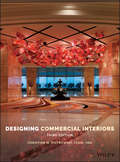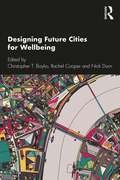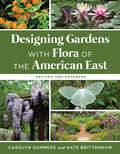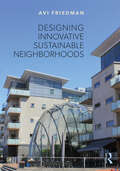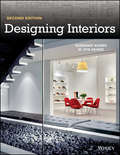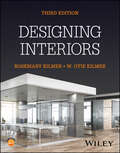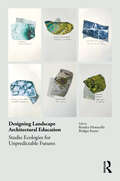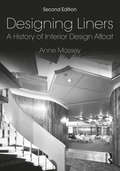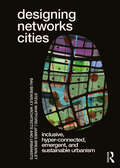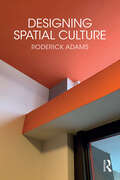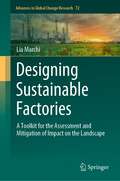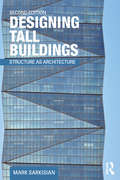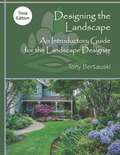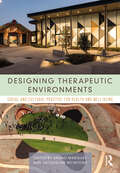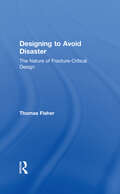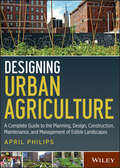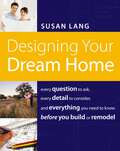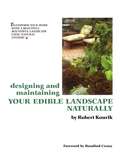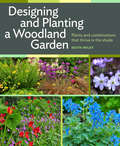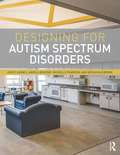- Table View
- List View
Designing Commercial Interiors
by Christine M. PiotrowskiA practical, comprehensive resource for commercial interior design Designing Commercial Interiors is the industry standard reference, now fully revised and expanded to reflect the latest developments in commercial interior design. This book guides you through the entire design process, from planning to execution, to teach you the vital considerations that will make your project a success. This new third edition includes new: Sustainability concepts for a variety of commercial spaces Coverage of accessibility, security, safety, and codes--and how these factors influence commercial design Chapters on design research, project process, and project management Drawings and photographs of design applications Supplemental instructor's resources Commercial interior design entails a much more complex set of design factors than residential design, and many of these considerations are matters of safety and law. This book walks you through the process to give you a solid understanding of the myriad factors in play throughout any commercial project, including how the global marketplace shapes designers' business activities. Whether it's a restaurant, office, lodging, retail, healthcare, or other facility, the interior designer's job is much more complicated when the project is commercial. Designing Commercial Interiors is an exhaustive collection of commercial design skills, methods, and critical factors for professionals, instructors, and those preparing for the NCIDQ exam.
Designing Commercial Interiors
by Christine M. PiotrowskiPractical, comprehensive resource for commercial interior design, covering research, execution, safety, sustainability, and legal considerations Designing Commercial Interiors explores the entire design process of commercial projects from planning to execution to teach the vital considerations that will make each project a success. This book delivers a solid understanding of the myriad factors in play throughout designing restaurants, offices, lodging, retail and healthcare facilities. Updates to the newly revised Fourth Edition include changes to office space design to promote flexibility, post-pandemic considerations for work and interior design, the latest industry certification requirements, sustainable design considerations. and safety/legal codes. Updated supplemental instructor’s resources, including a revised instructor’s manual with sample test questions and exercises are available on the companion website. A list of terms fundamental to each chapter has also been added at the end of each chapter. Other topics covered in Designing Commercial Interiors include: A thorough review of relevant design and research skills and methods How the global marketplace shapes designers’ business activities Product specification principles, WELL, and LEED certification and credentials Accessible design in facilities, elements of evidence-based design, and adaptive reuse Project manager responsibilities, working with stakeholders, and special considerations for executive-level clients Project delivery methods, including design-bid-build, design-build, and integrated design Designing Commercial Interiors is an authoritative and complete reference on the subject for university and community college students in programs related to interior design and those preparing for the NCIDQ exam. The text is also valuable as a general reference for interior designers less familiar with commercial interior design.
Designing Future Cities for Wellbeing
by Christopher T. BoykoDesigning Future Cities for Wellbeing draws on original research that brings together dimensions of cities we know have a bearing on our health and wellbeing – including transportation, housing, energy, and foodways – and illustrates the role of design in delivering cities in the future that can enhance our health and wellbeing. It aims to demonstrate that cities are a complex interplay of these various dimensions that both shape and are shaped by existing and emerging city structures, governance, design, and planning. Explaining how to consider these interconnecting dimensions in the way in which professionals and citizens think about and design the city for future generations’ health and wellbeing, therefore, is key. The chapters draw on UK case and research examples and make comparison to international cities and examples. This book will be of great interest to researchers and students in planning, public policy, public health, and design.
Designing Gardens with Flora of the American East, Revised and Expanded
by Carolyn Summers Kate BrittenhamAs recent years have seen alarming declines of insect and bird populations in many states, more gardeners have discovered the importance of including native plants in order to nurture these pollinators and sustain local ecosystems. But when so many popular landscaping designs involve exotic cultivars and invasive plant species, how can you create a garden that is both aesthetically pleasing and ecologically responsible? In this fully revised second edition of the classic guide Designing Gardens with Flora of the American East, gardening expert Carolyn Summers draws on the most recent research on sustainable landscaping. She is joined in this edition by her daughter, landscape designer Kate Brittenham, offering an intergenerational dialogue about the importance of using indigenous plants that preserve insect and bird habitats. The practical information they provide is equally useful for home gardeners and professionals, including detailed descriptions of keystone trees, shrubs, perennials, vines, and grasses that are native to the eastern United States. Accompanied by entirely new illustrations and updated plant lists, they offer chic yet eco-friendly landscape designs fully customized for different settings, from suburban yards to corporate office parks. The states covered in this book are CT, DE, IA, IL, IN, KY, MA, MD, ME, MI, MN, MO, NC, NH, NJ, NY, OH, PA, RI, TN, VA, VT, WI, and WV, as well as southern Quebec and Ontario.
Designing Innovative Sustainable Neighborhoods
by Avi FriedmanThis book covers fundamental aspects of neighborhood planning and architecture along sustainable principles. Written by a designer and instructor, the book’s fully illustrated chapters provide detailed insights into contemporary strategies that architects, planners and builders are integrating into their thought processes and residential design practices. Past approaches to planning and design modes of dwellings and neighborhoods can no longer sustain new demands and require innovative thinking. This book explores new outlooks on neighborhood design, which are propelled by fundamental changes that touch upon environmental, economic and social aspects. It presents contemporary well-designed and illustrated examples of communities and detailed analysis of topics including the depletion of non-renewable natural resources, elevated levels of greenhouse gas emissions and climate change. It also explores the increasing costs of material, labor, land and infrastructure, which pose economic challenges; as well as social challenges including the need for walkable communities and the increase in live-work environments. The need to think innovatively about neighborhoods is at the core of this book, which will be useful to students and practitioners of urban design, urban planning, geography and urban systems; and to architecture studios focused on sustainable residential development.
Designing Interiors
by W. Otie Kilmer Rosemary KilmerAfter its publication in 1992, Designing Interiors became a hugely successful reference tool and designing textbook. In Designing Interiors, Second Edition, updates on trends in sustainability and green design, building codes, universal design, and building information models amplify the already invaluable interior design tricks of trade. Design professors Rosemary and Otie Kilmer provide a fuller design history that incorporates non-Western design and dynamic color illustrations that flesh out technical concepts.
Designing Interiors
by W. Otie Kilmer Rosemary KilmerThe latest edition of the groundbreaking introduction to interior design Designing Interiors serves as a comprehensive overview of the basic knowledge required to become a professional interior designer. As the field of interior design evolves, education and practice continue to emphasize solid expertise in designing for people, their environments, and a better quality of life for all. This revised and updated Third Edition ushers in a new era of design for a new generation of interior designer students, with vital information on post pandemic design trends, additional coverage of sustainability, and key issues related to building codes. Design professors Rosemary and Otie Kilmer provide a complete design history that incorporates non-Western design and dynamic color illustrations that flesh out technical concepts. This third edition of Designing Interiors also includes: Space planning residential spaces post-pandemic Expanded sustainability guidance including Green Certification programs; WELL, FITWEL, Energy Star, and more Updated supplemental instructor resources and activitiesNew interior photographs illustrating today’s interior design projects Up to date information on “Interior Design as a Profession” post pandemic Intended primarily as an introduction to interior design at the college level, Designing Interiors, Third Edition can also be used in subsequent studio courses, and is an ideal resource for working professionals.
Designing Landscape Architectural Education: Studio Ecologies for Unpredictable Futures
by Rosalea Monacella and Bridget KeaneNo single project or endeavour is immune to the issues that the climate crisis brings. The climate crisis encompasses a broad register of "symptoms" – increased global temperatures and sea-level rise, droughts and extreme bushfire events, salinification and desertification of fertile land, and the list goes on. It reveals and amplifies complex causal relationships that are inherently present and traverse scales, sectors and communities divulging a range of impacts and inequalities. This publication asks designers and academic practitioners to describe their own work through an ecological lens, and then to articulate design approaches for developing new practices in landscape architecture teaching. Designing Landscape Architectural Education: Studio Ecologies for Unpredictable Futures, the Landscape Architecture Design Studio Companion, serves as a resource for academic practitioners in the preparation and delivery of "design-research studios" and students seeking guidance for design methodologies as a part of their landscape architectural education. It draws on the manifold issues of the climate crisis as a set of drivers to examine the utilisation of a range of innovative design approaches to address the current and future priorities of the discipline. The landscape architecture discipline is evolving rapidly to respond to both a broadening and intensification of changes in the environmental, social and political conditions. These changing conditions require innovation that extend the core competencies of landscape architects. This book addresses two fundamental questions – what are the design competencies required of landscape architects to equip them to deal with the complexities brought forth by contemporary society, and as a result, how could we design the future design studio?
Designing Liners: A History of Interior Design Afloat
by Anne MasseyDesigning Liners: A History of Interior Design Afloat covers the interior design of these floating palaces from the mid-nineteenth century to the twenty-first century. In this new edition, the design heritage of the ocean liner is also explored in this age of a growing holiday cruise market. The book offers the first history and analysis of this highly significant aspect of the design of interiors, which mirrors and reinforces cultural assumptions about national identity, gender, class and ethnicity. The interiors of ocean liners reflect the changing hierarchies of society and shifting patterns of globalization. The trajectory of the professionalization of interior design is the connecting narrative of the book, from the local decorating firm to the internationally renowned architect. It is an important addition to interior design research and takes this transitory building type as its subject. This book provides the first survey of the transient history of interior design in relation to the development of passenger shipping. The history of these great ship interiors is tracked, from their commissioning by the line owners; the materials, methods and sources for the initial creation; their construction; their use and reception. The demise and re-purposing of the interiors is also covered in this new edition, with additional material on the South African Union Castle and P & O lines. Drawing on a broad range of original research, Anne Massey’s approach combines interior design studies, design history, architectural history and maritime studies. The new edition has been carefully designed to include black and white and colour illustrations.
Designing Liners: A History of Interior Design Afloat
by Anne WealleansThis in-depth history of the interior design of ocean liners surveys the transient history of interior design in relation to the development of passenger shipping, from commissioning by the line owners, methods and sources for the original creation of designs through to its construction, use and influence. It is a short-lived branch of architecture and design, lasting an average of fifteen years. As the design and taste mirrors and reinforces cultural assumptions about national identity, gender, class and race, not only did the interiors of ocean going liners reflect the changing hierarchies of society and shifting patterns in globalization, but the glamour and styling of the liners were reflected back into the design of interiors on land. Combining design history, architecture history, material and visual cultures, Designing Liners is a richly multidisciplinary work for those studying or researching this application of interior design.
Designing Networks Cities: Inclusive, Hyper-Connected, Emergent, and Sustainable Urbanism
by Steve Whitford James Brearleydesigning networks cities presents a sophisticated, multi-disciplinary, and multi-dimensional approach to urban design. Emerging from years of practice, experimentation, and research by designers (landscape architects, urban planners, urban designers and architects), this approach engages with contemporary thought across a number of disciplines to re-invent the entrenched blunt instruments of the city making process. A cry for flexible, sharp-instruments in urban design, designing networks cities presents a multi-dimensional way of seeing the essential components of the city (form, space-time, order and aesthetics). It purposefully links traditional architectural design derivation mechanisms to urban design, in the hope that cities will not only be pragmatic, but also become sophisticated iconographically, poetically, and syntactically. It provides the tools to enable decision making within a multiplicity of constraints and opportunities: a philosophy of becoming, not being; a science of dynamic systems, not stasis; and an art of sensations, not subjectivity. And finally, and most importantly, it argues why it is important that cities embrace these multiple dimensions of society on a planet that is facing increasing environmental challenges: an economics focused on equity for all, not for some more than others; a politics supporting a genuine representational democracy, not one representing the overly influential; and a culture [including history] that embraces difference, not one that encourages division. designing networks cities not only provides the means to identify these issues and a methodology to deal with them within a complex emerging co-existence, but also demonstrates the development of cities that embrace and respond to the complexities of life in what some are calling the Anthropocene.
Designing Rainwater Harvesting Systems
by Kathy M. Debusk Eddie Van Giesen Celeste Allen NovakWater conservation is one of the most effective sustainable design practices, yet few professionals know how to collect and use rainwater effectively. Rainwater Harvesting the first comprehensive book on designing rainwater harvesting systems. It provides practical guidelines for developing a rainwater harvesting strategy, taking into account climate, public policies, environmental impact, and end uses. Case studies are included throughout. Rainwater Harvesting is a valuable reference for architects, landscape architects, and site engineers.
Designing Spatial Culture
by Roderick AdamsDesigning Spatial Culture investigates a powerful experiential dialogue formed between the habitation of space and a diversified cultural realm. This creative proposition binds and positions human activity and experience framing its histories, currency and future. Whilst the book distinguishes between the conditions of the existing urban/ architecture/ interior canon, it embraces a new agency of space, showcasing the encounters, assemblies and designs that shape human behaviours and the cultural forms of the built environment. Using authoritative case studies, the book examines many locations and spaces, ranging from new urban landscapes, historical domestic spaces and contemporary architecture. It embraces the most lavish and flamboyant to the most simplistic and minimal, establishing a connected cultural narrative. The book shifts the focus in the spatial realm from an object-based experience (where space is filled with things) to a more complete immersive experience (combining physical and digital). A key part of this exploration is the relationship between the architecture and the interior which is often the most predominant spatial experience and fundamental to the understanding spatial experience and existing cultures. Without the architectural enclosure, the interior would lose its site context and structure for its existence. Without an interior, architecture would not fully develop an engaging spatial experience for the user. The book rationalises this through extended use of a spatial probe which documents and summarises an evidence-based research project capturing spatial culture data from a predominantly domestic setting. The book is essential reading for students and researchers in architecture, interior design and urban design.
Designing Sustainable Factories: A Toolkit for the Assessment and Mitigation of Impact on the Landscape (Advances in Global Change Research #72)
by Lia MarchiEconomic constraints and lack of knowledge often prevent companies - especially small and medium enterprises - from harmonizing their facilities with the landscape. As a result, factories significantly impact the quality of our living environment, in terms of physical effects on the ecosystem, perceptual interferences with the surroundings, and disturbances on local communities. At both the design and maintenance stages, a set of appropriate tools can assist businesses in becoming more aware of their impacts and identifying possible mitigation strategies. The book presents an assessment tool and a library of inspiring design tactics for factories, with examples of the benefits and synergies for the environment, the scenery, the community, and the company itself. The purpose is to elicit more than a simple reflection about what a sustainable factory entails. It is rather to encourage and assist both businesses and designers in mitigating the impact of industrial facilities on the landscape as holistically as possible.
Designing Sustainable Forest Landscapes
by Simon Bell Dean ApostolDesigning Sustainable Forest Landscapes is a definitive guide to the design and management of forest landscapes, covering the theory and principles of forest design as well as providing practical guidance on methods and tools. Including a variety of international case studies the book focuses on ecosystem regeneration, the management of natural forests and the management of plantation forests. Using visualisation techniques, design processes and evaluation techniques it looks at promoting landscapes which are designed to optimise the balance between human intervention and natural evolution. A comprehensive, practical and accessible book, Designing Sustainable Forest Landscapes is essential reading for all those involved in forestry and landscape professions.
Designing Tall Buildings: Structure as Architecture
by Mark SarkisianThis second edition of Designing Tall Buildings, an accessible reference to guide you through the fundamental principles of designing high-rises, features two new chapters, additional sections, 400 images, project examples, and updated US and international codes. Each chapter focuses on a theme central to tall-building design, giving a comprehensive overview of the related architecture and structural engineering concepts. Author Mark Sarkisian, PE, SE, LEED® AP BD+C, provides clear definitions of technical terms and introduces important equations, gradually developing your knowledge. Projects drawn from SOM’s vast portfolio of built high-rises, many of which Sarkisian engineered, demonstrate these concepts. This book advises you to consider the influence of a particular site's geology, wind conditions, and seismicity. Using this contextual knowledge and analysis, you can determine what types of structural solutions are best suited for a tower on that site. You can then conceptualize and devise efficient structural systems that are not only safe, but also constructible and economical. Sarkisian also addresses the influence of nature in design, urging you to integrate structure and architecture for buildings of superior performance, sustainability, and aesthetic excellence.
Designing The Landscape: An Introductory Guide For The Landscape Designer
by Tony BertauskiEvery professional landscape designer develops his or her own design process, emphasizing some steps while minimizing or eliminating others. It's important to learn every aspect of the process before getting on the job. Bertauski's comprehensive and readable Designing the Landscape presents every facet of the design experience from client interviews and concepts through presenting and pricing a master plan, so students can learn what works and what doesn't when they still have the time and opportunity to make valuable mistakes. The author's focus on topics that foster understanding of the functionality and aesthetics of design equips students with skills they need to be effective designers. While residential design is emphasized, many concepts and steps can be applied to commercial projects. Also available from Waveland Press by Tony Bertauski, Plan Graphics for the Landscape Designer with Section-Elevation and Computer Graphics, Third Edition (ISBN 9781478637264).
Designing Therapeutic Environments: Social and Cultural Practice for Health and Well-Being
by Bruno Marques Jacqueline McIntoshThis book draws on the relationship between culture and the environment and its connection with health and well-being. Therapeutic environments are settings that comprise the physical, ecological, psychological, spiritual and social environments associated with treatment and healing. Throughout the chapters, the understanding of therapeutic environments is broadened through the exploration of specific Indigenous cultural and social dimensions. Case studies comprise a combination of research papers regarding the theoretical and conceptual underpinnings of therapeutic environments and their application following traditional methods. This book contributes to the expanding body of knowledge focusing on the role of therapeutic environments and their role in shaping health and well-being through the development of new research methods.This book is essential for practitioners, scholars and students in architecture, landscape architecture, interior architecture, urban design, planning, geography, building science, public health and environmental engineering.
Designing To Avoid Disaster: The Nature of Fracture-Critical Design
by Thomas FisherRecent catastrophic events, such as the I-35W bridge collapse, New Orleans flooding, the BP oil spill, Port au Prince's destruction by earthquake, Fukushima nuclear plant's devastation by tsunami, the Wall Street investment bank failures, and the housing foreclosure epidemic and the collapse of housing prices, all stem from what author Thomas Fisher calls fracture-critical design. This is design in which structures and systems have so little redundancy and so much interconnectedness and misguided efficiency that they fail completely if any one part does not perform as intended. If we, as architects, planners, engineers, and citizens are to predict and prepare for the next disaster, we need to recognize this error in our thinking and to understand how design thinking provides us with a way to anticipate unintended failures and increase the resiliency of the world in which we live. In Designing to Avoid Disaster, the author discusses the context and cultural assumptions that have led to a number of disasters worldwide, describing the nature of fracture-critical design and why it has become so prevalent. He traces the impact of fracture-critical thinking on everything from our economy and politics to our educational and infrastructure systems to the communities, buildings, and products we inhabit and use everyday. And he shows how the natural environment and human population itself have both begun to move on a path toward a fracture-critical collapse that we need to do everything possible to avoid. We designed our way to such disasters and we can design our way out of them, with a number of possible solutions that Fisher provides.
Designing Urban Agriculture
by April PhilipsA comprehensive overview of edible landscapes-complete with more than 300 full-color photos and illustrations Designing Urban Agriculture is about the intersection of ecology, design, and community. Showcasing projects and designers from around the world who are forging new paths to the sustainable city through urban agriculture landscapes, it creates a dialogue on the ways to invite food back into the city and pave a path to healthier communities and environments. This full-color guide begins with a foundation of ecological principles and the idea that the food shed is part of a city's urban systems network. It outlines a design process based on systems thinking and developed for a lifecycle or regenerative-based approach. It also presents strategies, tools, and guidelines that enable informed decisions on planning, designing, budgeting, constructing, maintaining, marketing, and increasing the sustainability of this re-invented cityscape. Case studies demonstrate the environmental, economic, and social value of these landscapes and reveal paths to a greener and healthier urban environment. This unique and indispensable guide: Details how to plan, design, fund, construct, and leverage the sustainability aspects of the edible landscape typology Covers over a dozen typologies including community gardens, urban farms, edible estates, green roofs and vertical walls, edible school yards, seed to table, food landscapes within parks, plazas, streetscapes and green infrastructure systems and more Explains how to design regenerative edible landscapes that benefit both community and ecology and explores the connections between food, policy, and planning that promote viable food shed systems for more resilient communities Examines the integration of management, maintenance, and operations issues Reveals how to create a business model enterprise that addresses a lifecycle approach
Designing With Light
by Jason LivingstonA comprehensive introduction to the theory and practice of lighting designDesigning With Light: The Art, Science, and Practice of Architectural Lighting Design is a comprehensive introduction to the intelligent use of lighting to define and enhance a space. The book explores all aspects of the process, including aesthetics, technology, and practicalities, in a clear, concise manner designed to provide the reader with a full working knowledge of lighting design. Color illustrations throughout demonstrate the real-world effects of the concepts presented, and the companion website offers video animations and exercises to better illuminate the art and science of lighting. The book addresses the considerations that should be a part of any designer's process, and provides thorough guidance on meeting the various demands with smarter design.Lighting is an essential element of interior design, and despite its ubiquity, is difficult to truly master. A designer with a fundamental and conceptual understanding of light is empowered to create simple, typical spaces, or work intelligently with lighting consultants on more complex projects. Designing With Light contains special discussions on color, light, and health, as well as the latest information on energy efficient lighting, control systems, and other technologies. Topics include:Physics, psychology, and perception of lightCurrent and future lighting technologyCommunication, documentation, and the design processSustainability, daylighting, and energy efficiencyThe book also contains an entire chapter on building and energy codes, as well as practical guidance on photometrics and calculations. Lighting can make or break an otherwise well-designed space, so designers need the background to be able to think intelligently about illumination factors during all stages of the process. With comprehensive coverage and thorough explanation, Designing With Light is a complete resource for students and professionals alike.
Designing Your Dream Home: Every Question to Ask, Every Detail to Consider, and Everything to Know Before You Build or Remodel
by Susan LangYou can have the home of your dreams!This comprehensive guide walks you through every decision and addresses all the details that most homeowners don't even know to consider.In this step-by-step, room-by-room handbook, Susan Lang considers every aspect of your homebuilding or remodeling project, such as how to Hire the right architect, interior designer, and builder Design each room to perfectly fit your family's lifestyle Plan ahead so all your storage needs are met Determine the perfect placement for light fixtures, switches, and electrical outlets Save money by avoiding costly design revisions or building change ordersYou'll find helpful forms and checklists that will keep you organized and assist you in clarifying your needs. And if you're worried that building your dream home might turn into a nightmare, Designing Your Dream Home covers the most common mistakes that homeowners make and shows you how to avoid them. Susan Lang has thought of everything, so you won't have to.
Designing and Maintaining Your Edible Landscape Naturally
by Robert KourikFirst published in 1986, this classic is back in print by popular demand. It is the authoritative text on edible landscaping, featuring a step-by-step guide to designing a productive environment using vegetables, fruits, flowers, and herbs for a combination of ornamental and culinary purposes. It includes descriptions of plants for all temperate habitats, methods for improving soil, tree pruning styles, and gourmet recipes using low-maintenance plants. There are sections on attracting beneficial insects with companion plants and using planting to shelter your home from erosion, heat, wind, and cold.
Designing and Planting a Woodland Garden: Plants and Combinations that Thrive in the Shade
by Keith WileyFrom the creator of "one of the most exciting and innovative gardens in Britain today" With their moss-covered stones, towering trees, and pockets of quiet shade, woodlands have a romantic power unlike anything else. Whether your garden is currently open and sunny, or on the small side, you can capture that sylvan atmosphere with carefully chosen trees and shade-loving plants. In Designing and Planting the Woodland Garden, Keith Wiley explains how to combine plants in natural, self-supporting colonies. His hand-picked selection of unexpected collectables—shrubs, perennials, bulbs, ferns, and grasses—mingle with garden favorites to create fabulous effects in all seasons.
Designing for Autism Spectrum Disorders
by Angela Bourne Michelle Pearson Kristi Gaines Mesha KleibrinkWinner of the 2017 IDEC Book Award, 2017 EDRA Great Places Award (Book Category), 2017 American Society of Interior Designers Joel Polsky Prize and the 2016 International Interior Design Association TXOK Research Award Designing for Autism Spectrum Disorders explains the influence of the natural and man-made environment on individuals with autism spectrum disorders (ASD) and other forms of intellectual/developmental disabilities (IDD). Drawing on the latest research in the fields of environmental psychology and education, the authors show you how architecture and interior spaces can positively influence individuals with neurodiversities by modifying factors such as color, lighting, space organization, textures, acoustics, and ventilation. Now you can design homes, therapeutic environments, work environments, and outdoor spaces to encourage growth and learning for the projected 500,000 children with ASD (in the United States alone) who are expected to reach adulthood by 2024. Topics discussed include:-Environmental design theories-Symptoms of ASD-Sensory processing deficits -Design needs of individuals on the spectrum at all ages-Design methods and solutions for spaces, including residential, learning, work, and therapeutic environments encompassing a wide range of budgets-Designing for self-actualization, well-being, and a high quality of life for the duration of an individual's life-Avenues for healthy living and aging in place-Biophilic design-Environmental impact on well-being -Strategies to promote active living as an integral part of the welfare focus.
